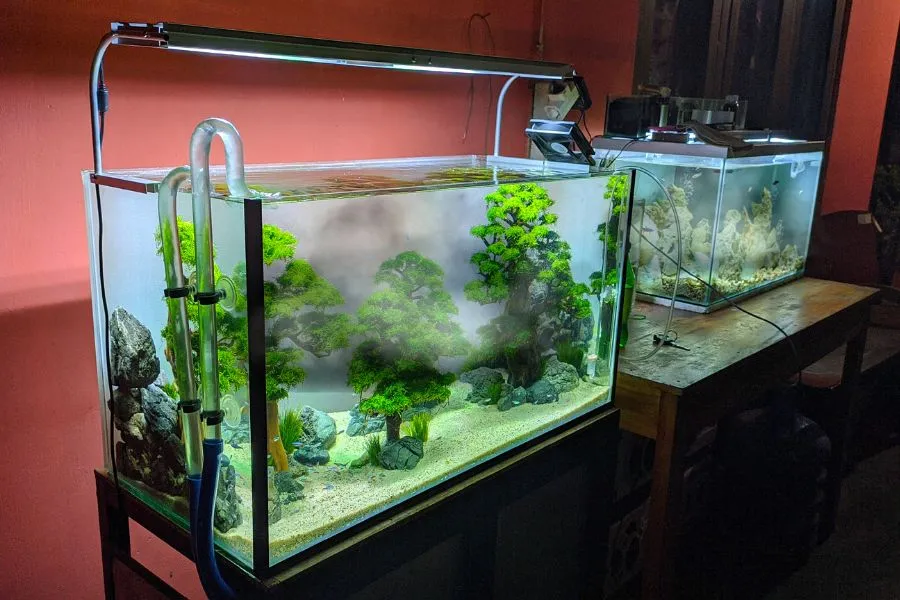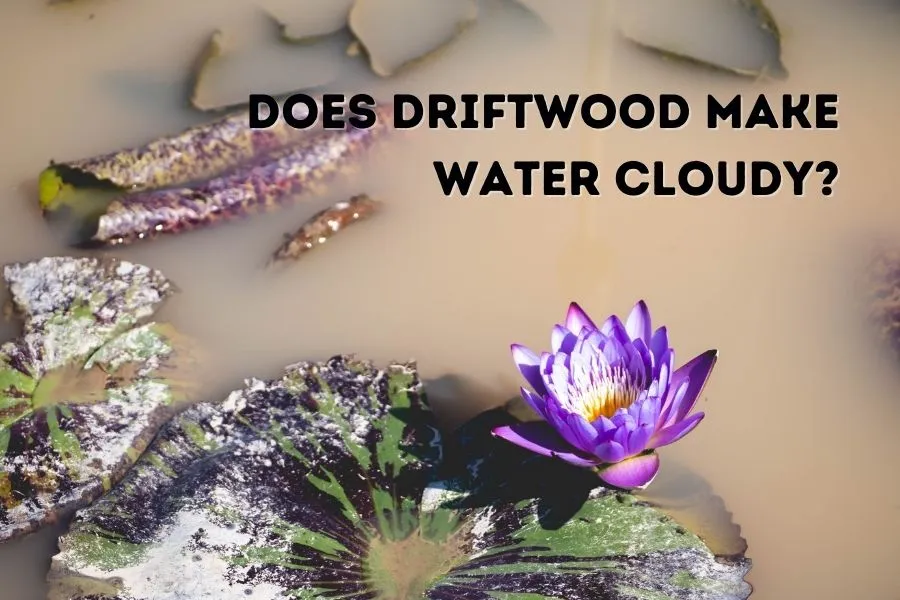All of a sudden the water in an aquarium can be cloudy. Or, if you’ve set up a new aquarium it can be cloudy after only a week. Driftwood is commonly added to aquariums and looks great, and in this article I will explain if driftwood makes water cloudy.
In general, driftwood does not make water cloudy. Driftwood typically dyes the water a tea color. Cloudy water is caused by a bacterial bloom, or an issue with the water filter. First check the water filter is functioning correctly, but a bacterial bloom will go away after 2 days on it’s own.
Below, I will list the different reasons why an aquarium will get cloudy, how long it takes for cloudy water in an aquarium to go away, and important info about what driftwood does to the water in an aquarium.

READ MORE: How to preserve Driftwood
Causes of Cloudy Water in an Aquarium [& How To Fix It]
While cloudy water in an aquarium sometimes is no cause for concern, it’s important to know in detail what all the causes are and how to make the water clear again.
That way you can rest easy that the fish and animals in your aquarium will be OK. Here’s a summary of the reasons why aquarium goes cloudy, followed by an in depth discussion about what to do when it happens.
Overall, a bacterial bloom is the most common cause of cloudy water in an aquarium, but the water filter can also have an issue. Cloudy water in an aquarium always temporary and will go away after a few days without doing anything. But, also check your water filter is functioning correctly.
The thing with a bacterial bloom is that is takes a few days to go away. Therefore, you should check the water filter is functioning correctly.
Otherwise, the water filter can not be working, and the cloudiness of the tank will get worse over time, or won’t go away on it’s own. Here is a really good video that shows how to check, clean, and maintain virtually all aquarium water filters out there:
What causes a bacterial bloom to occur
A bacterial bloom occurs when some factor causes the bacteria in an aquarium to increase in numbers A LOT. So much so that the water becomes cloudy with the amount of bacteria in the water.
Bacteria only live for 12 to 24 hours according to Science Focus. When bacteria numbers are normal, the bacteria will go through their lifecycle, and die at a rate where they won’t cloud the water.
But, there are a few factors that can cause bacteria numbers to spike, and make the water go cloudy.
Bacteria numbers grow very large in a short period of time because of:
- An over abundance of ammonia
- Warmer temperatures
- Manually adding bacteria (you will know if you did this)
Bacteria need a food source. In aquariums this is ammonia. Ammonia at high levels is harmful to fish and animals, so beneficial bacteria that consume ammonia is required in fish tanks.
The number of beneficial bacteria in an aquarium balances out based on how much ammonia there is. If more bacteria grow then there is food to feed them, the excess bacteria will die from starvation.

If a lot of ammonia has accumulated in your tank for some reason, then the bacteria will have so much food than fewer bacteria will die. Therefore, bacteria numbers will spike.
Extra ammonia can get into a tank if added too much fish food. Any fish food that is not eaten will accumulate on the bottom of the tank and decompose. After about a week additional ammonia will be released by the decaying fish food. And cause a spike in bacteria numbers.
RELATED: Can I Have Too Much Driftwood in my Aquarium?
Warmer temperatures than normal in and around the tank
Bacteria also tend to grow best in warm temperatures above room temperature according to the California State Polytechnic University (source).
They found that some of the more common beneficial bacteria in aquariums grow fastest at 86 °F to 95 °F (30 °C to 35 °C). Whereas, water at room temperature is 78 °F (25.5 °C).
There could have been warmer day, or a few warmer days than normal. Which increased the number of bacteria that grew.
A heater could also have been placed in a room because of cooler weather. Causing a more favorable environment for bacterial growth. Driftwood does discolor the water, but will not make it go cloudy.
How To Clear Water After Adding Driftwood
After you add driftwood the water in an aquarium can turn a transparent dark brown. As well as, other colors based on what type of wood is used. While some people like the look of colored water, some people prefer clear water, so here is how to make water clear when it has been discolored because driftwood was added to the tank.
In general, add a piece of activated charcoal into your water filter, it will clear the water in under a week. Otherwise, it will clear on it’s own. But, the color will take a month or two to be completely gone. In some cases, a very minor tint will remain depending on the type of wood.
For example, some woods will discolor the water even after a few months have passed, or if you put activated charcoal in water filter. This varies based on the species of wood.
But, the most discoloration of the water will generally occur when you first put the driftwood in the tank. It can be lessened by preparing the driftwood beforehand by boiling the piece of driftwood in water for 10 to 12 hours.

Will Driftwood Stop Releasing Tannins
It’s well known, that driftwood will release tannins into the water in an aquarium, and the most visible sign that this is happening is the water changing color. What tannins are and how they work is not something that is common knowledge, so here’s the long and short of whether driftwood will stop releasing tannins.
Overall, driftwood will not stop releasing tannins. Tannins are released whenever any plant material decomposes. Driftwood will always decompose slowly, and therefore, always release tannins. But, tannins levels are insignificant after a few months, or if driftwood is prepared to remove the tannins.
Tannins get their name because the bark of certain trees are used to dye leather – known as leather tanning. Tannins in wood are slowly released from the wood. Interestingly, some rivers in nature have a brown tint to them. This occurs because these rivers contain a lot of plant leaves, and branches that are high in tannins.

